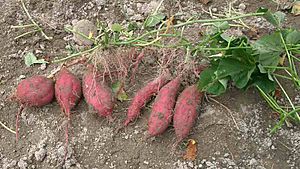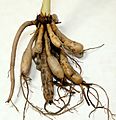Tuber facts for kids
A tuber is a special, swollen part of a plant's underground stem. Think of it like a storage cupboard for the plant! Tubers, like the potato, have tiny buds, often called "eyes," which can grow into new plants.
Most tubers grow underground, but some plants, like the air potato (Dioscorea bulbifera), can even grow them above ground on their stems!
What Do Tubers Do?
Tubers are like natural food banks for plants. They get big and round to store important nutrients. The main food they store is starch, which is made from many tiny glucose molecules. Some plants, like the Jerusalem artichoke (Helianthus tuberosus), store a different type of sugar called inuline, which is made from fructose molecules.
The two main jobs of tubers are:
- Storing food: They keep the plant fed, especially during colder months.
- Helping the plant reproduce: They allow new plants to grow.
When autumn or winter arrives, the parts of the stem connecting the tubers to the main plant often die. But the tubers stay safe underground. When spring comes, they use their stored food and buds to sprout new shoots and grow into new plants!
Farmers also use tubers to grow more plants. They cut a potato tuber into pieces, making sure each piece has at least one "eye" (a group of buds). These pieces, called "seed pieces," are then planted, and each one can grow into a brand new potato plant.
What Are Tuberous Roots?
Sometimes, you might hear about "tuberous roots." These are similar to tubers because they also store food and look a bit like them, but they are actually swollen roots, not stems. So, while they do a similar job, they grow from a different part of the plant.
Plants with important tuberous roots include the sweet potato, cassava, yam, and dahlia.
Related Plant Parts
Images for kids
See also
 In Spanish: Tubérculo para niños
In Spanish: Tubérculo para niños










